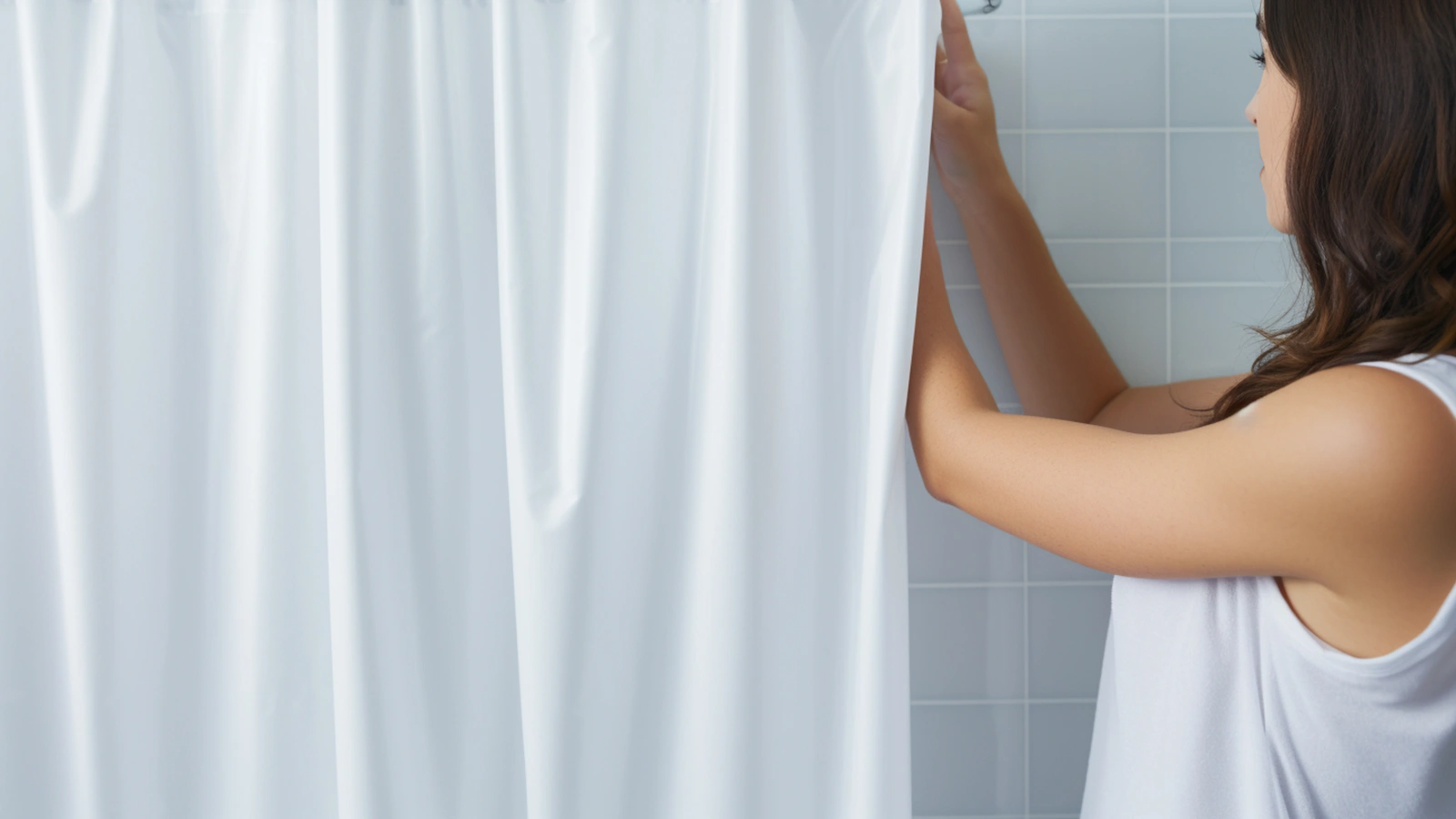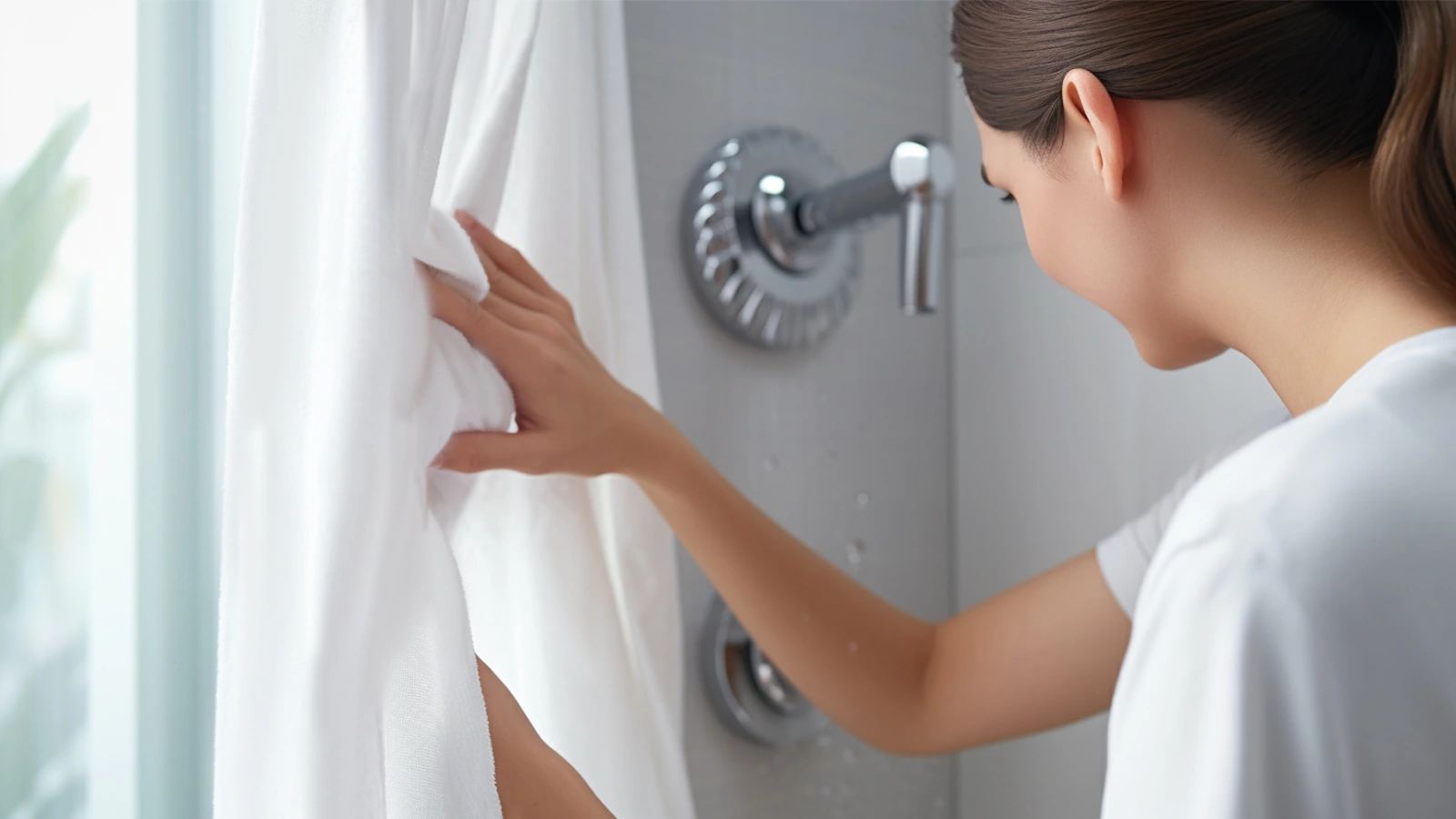Is Mold on Shower Curtain Dangerous? Shocking Causes and 5 Solutions Unveiled
Your shower curtain might be masquerading as a simple bathroom fixture. But beneath its folds lurks a silent adversary: mold. You must be curious about “Is mold on shower curtain dangerous?”
Molds are more than just an eyesore. They can harm your health by releasing spores into the air you breathe. These spores can aggravate allergies, attack your respiratory system, and sometimes lead to severe infections.
It’s essential that you don’t ignore the mold on your shower curtain. You’ve got to address it promptly to maintain a clean and safe bathroom environment. This brief guide will give you the know-how to eradicate mold and keep your shower space pristine and healthy.
Table of Contents
Is Mold on Shower Curtain Dangerous?

You’re at risk when your shower curtain harbors mold. Mold can exacerbate allergies and cause respiratory issues. Mold and mildew thrive in the damp environment of your bathroom, turning your shower curtain into a potential health hazard.
Exposure to mold spores, especially from black mold, can provoke allergic reactions and worsen asthma symptoms. It’s crucial to keep an eye out for these unwelcome guests on your shower curtain to mitigate any health risks.
Regular cleaning and ensuring your bathroom is well-ventilated are vital steps to prevent mold growth. If you’ve got a leak, fix it quickly and consider investing in mold-resistant shower curtains.
Staying proactive protects your health and keeps those pesky spores at bay.
What Causes Mold to Grow on Shower Curtains?
The mold growth on your shower curtain is primarily due to the persistent dampness and lack of airflow in bathroom environments. When you shower, humidity levels rise, creating the perfect breeding ground for mold and mildew. Poor ventilation means this moisture can’t escape, and the wet surface of your shower curtain becomes a haven for mold spores to settle and multiply.
Over time, not only can this mold growth make your shower curtain unsightly, but it might also make you sick. This is especially serious if you’re sensitive to or allergic to mold.
How to Clean Mold from a Shower Curtain: A Step-by-Step Guide
You’ve spotted mold on your shower curtain, and it’s time to tackle the cleanup.
Prepare the Necessary Cleaning Supplies

You must gather the right cleaning supplies before tackling the mold on your shower curtain. Ensure you have everything on hand to remove the fungus and protect your health effectively.
Start with protective gear. Gloves and a mask are essential to prevent inhaling mold spores or coming into contact with the fungus.
For the type of mold in your shower, consider a mix of bleach and water or a commercial mold cleaner. Both are known to kill any lingering bacteria and mold effectively. If you prefer natural solutions, hydrogen peroxide and baking soda are great alternatives.
Don’t forget a brush or sponge for scrubbing and a bucket for your cleaning solution.
Lastly, ensure your shower area is well-ventilated during and after the process to discourage mold growth.
Remove the Shower Curtain

Take down the shower curtain carefully to avoid dispersing spores around your bathroom. Fold it inward as you remove it from the rod to trap any loose mold within. This step is crucial to reduce mold exposure and prevent black mold spores from contaminating other areas.
Once down, lay the shower curtain flat, either outside or in the tub, to tackle the mold directly. You’re now ready to clean the shower curtain mold effectively. Remember, handling mold with care is essential for your health and keeping your bathroom a safe, hygienic space.
With the curtain removed, you can proceed to the cleaning solutions that will restore your shower curtain to a mold-free state.
Pre-Treatment
After removing your shower curtain and laying it flat, you’ll want to start the pre-treatment by targeting the mold with a natural, potent cleaning solution. To tackle this, create a spray by mixing equal parts hydrogen peroxide and water. Coat the moldy areas thoroughly, getting into the creases and seams. Let the solution sit for a while to break down the mold.
Next, make a paste with baking soda and water, and scrub the affected spots. This pre-treatment will help loosen the mold, making it easier to wash away.
If you’ve spotted mold in your shower, it’s not just unsightly. It’s potentially dangerous. Mold exposure can exacerbate asthma, trigger coughing, and negatively affect your health.
Wash the Shower Curtains

Once your shower curtain’s pre-treatment has taken effect, it’s time to wash the curtains for a thorough clean. If the curtain is machine-washable, you can use your washing machine. Hand washing is also an effective alternative if your curtains aren’t machine washable.
Place it in the washer, adding a few towels for extra scrubbing action.
Add your regular laundry detergent along with baking soda for its mild abrasive and deodorizing properties.
Select the gentlest cycle to avoid damaging the curtain.
Remember, if you don’t address shower curtain mold promptly, the damp environment of your bathroom ensures mold will grow back.
So after the wash, allow the curtain to drip dry, preventing any residual moisture from lingering.
This is how to clean shower curtain mold effectively, keeping your bathroom fresh and hygienic.
Dry the Shower Curtains
Once you’ve washed the curtain on the lowest gentle setting, don’t stuff it in the dryer. Instead, hang it back up in the shower or a well-ventilated area to air dry. The key is to allow air to circulate freely, which helps discourage any lingering spores from settling back in.
How to Prevent Mold on Shower Curtains

You’ve learned about the dangers of mold on your shower curtain, but let’s talk about how to stop it before it starts.
Ventilation
To effectively prevent mold on your shower curtain, ensure at least one form of ventilation is in place. You can use an exhaust fan or an open window during and after your shower. Proper ventilation reduces the moisture that mold thrives on, combating the dangerous effects it can have on your health.
Make sure to keep the air moving. This can be as simple as leaving the bathroom door open if privacy isn’t a concern.
Daily Drying
Implementing a daily drying routine is one of the simplest ways to prevent mold growth on your shower curtain. Ensuring your shower curtain is fully extended after each use allows air to circulate and helps to stop mold in its tracks.
Don’t just shake it off and hope for the best. Take a towel and wipe down any residual moisture. This simple step is key to combating shower mold and keeping black mold in the shower at bay.
Regular Cleaning
Regular cleaning is your best defense against mold growth on your shower curtain. You’ll need a consistent strategy to tackle the pesky mold in your shower.
It’s not just about attacking the visible shower curtain mold. It’s about preventing it. Start using a mildew-resistant liner and ensure you’re cleaning regularly.
Wondering how to clean shower curtain mold? Mix a solution of equal parts water and vinegar. Spray it onto the curtain. Scrub the mold away. For tougher mold, baking soda can be added to the mix. After you’ve finished, rinse the curtain thoroughly and let it dry completely.
Don’t forget to maintain this routine to keep mold at bay.
Mold-Resistant Materials

You’ll significantly reduce your risk of mold by choosing shower curtains made of mold-resistant materials. Opting for nylon, polyester, or vinyl can keep the worries of mold in my shower at bay. These fabrics are less likely to harbor shower mold. Switching to these materials can be a game-changer if black mold in the shower has been a past issue. They don’t just repel mold. They’re also easy to clean, so you can quickly tackle cleaning shower curtain mold.
Avoid Toiletry Clutter
During your daily shower routine, minimize toiletry clutter to reduce areas where mold can easily grow on your shower curtain. Overcrowded shelves and heaps of products create damp nooks, perfect for mold to thrive.
Keeping a tidy shower space not only preserves the longevity of your curtain but also protects your health by preventing mold growth.
Conclusion
So there you have it—you’re now equipped to combat mold on your shower curtain. Remember, it’s not just about aesthetics; it’s a health imperative.
Keep your bathroom well-ventilated and shower curtain dry, and stay on top of regular cleanings. Don’t let mold’s threats linger. By taking these proactive steps, you’ll ensure your shower remains a clean and safe retreat.
Let’s keep those mold spores at bay and enjoy a refreshing shower experience.
FAQs
Q: Can mold on a shower curtain make you sick?
A: Yes, mold on a shower curtain can make you sick, especially if you have allergies or respiratory conditions. It’s essential to address any mold issues promptly to avoid health problems.
Q: What are the effects of black mold in the shower?
A: Black mold in the shower can cause respiratory problems, allergies, and other health issues. It’s essential to address black mold promptly and take steps to prevent its growth in the future.
Q: How can I help prevent mold from growing in my shower?
A: To prevent mold from growing in your shower, ensure proper ventilation, regularly clean and dry the shower area, and address any leaks or moisture issues promptly.
Q: Can a shower liner help prevent shower mold?
A: A shower liner can help prevent shower mold by providing an extra barrier against moisture and mold growth. Be sure to keep the liner clean and dry to maximize its effectiveness.







